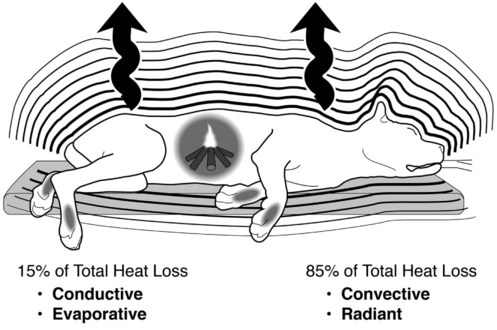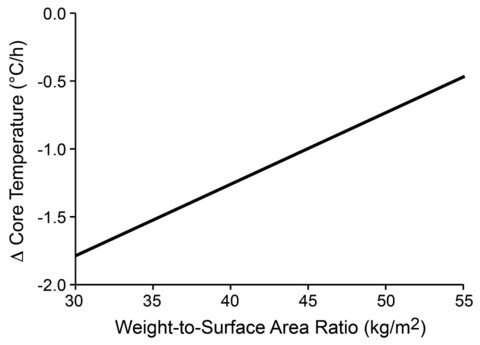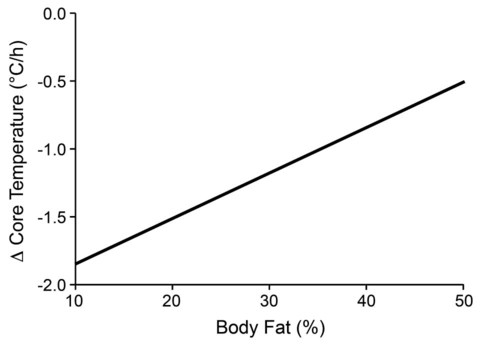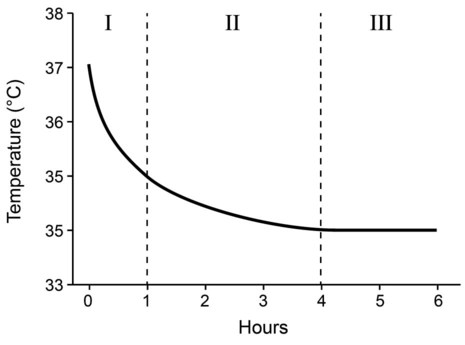I Thermoregulation is a complex function of both central and peripheral mechanisms and is easily influenced by environmental and therapeutic manipulations. Abnormal body temperature in conscious animals is an indicator or a cause of metabolic dysfunction. Abnormal body temperature in anesthetized animals is a direct consequence of anesthetic–drug-related effects, environmental factors, and the temperature, volume, and rate of intravenous (IV) fluid administration. A Normal body temperature in dogs and cats is narrowly regulated ± 0.2° C around its set point but can range from 37.8° C to 39.2° C (100° F to 102.5° F) B Major body systems involved in thermoregulation include the central nervous system (CNS), cardiovascular system, respiratory system, musculoskeletal system, and skin II Thermoregulatory mechanisms A Cold and warm sensors are located in or beneath epidermal skin B Temperature signals are transmitted through A-δ and C-fibers in peripheral nerves: cold signaling is through A-δ fibers, warm signaling is through C-fibers C Thermal afferent nerves transmit information to the lateral spinothalamic tract D Central regulation is in the hypothalamus E The initial response of the body to temperature variation occurs in blood vessels and is regulated by α1– and α2-receptors; α2-receptors are important regulators of arterial-venous shunt vessels in peripheral tissues III Heat loss mechanisms (Fig. 17-1) 1. Loss of heat to surrounding air via electromagnetic waves 2. Radiant heat loss is proportional to the temperature difference between the animal and the environment 3. Loss of heat through radiation accounts for approximately 60% of heat loss in humans 1. Loss of heat to objects directly in contact with the body a. Examples include cold operating tables, infusions of cool fluids and blood products, irrigation with cool solutions C Convection (facilitated conduction) 1. Loss of body temperature to colder objects not in direct contact with the body, such as cold operating room walls, or due to ventilation or induced air currents across body surfaces 2. Heat loss is a result of three factors: moving air, exposed tissue, cold ambient temperature 3. Rate of convective heat loss increases with increased airflow 4. Even warm airflow can result in convective heat loss from body surfaces A Can be considered any temperature below a core body temperature of 37.8° C (100° F) 1. Occurs when heat loss exceeds heat production 2. Inadvertent hypothermia during general anesthesia is the most common perioperative thermal disturbance B Rate of heat loss is related to species, animal’s weight, animal’s current temperature, and animal’s percentage of body fat 1. Hypothermia is common in small animals due to their increased body surface area compared with their smaller body mass (Fig. 17-2) 2. Increased body fat is associated with a decreased rate of heat loss (Fig. 17-3) 3. Three phases are typically associated with intraoperative hypothermia (Fig. 17-4) C Three categories of hypothermia have been defined (Table 17-1) TABLE 17-1 1. Mild: body temperature between 32° C and 37° C (89.6° F to 98.6° F) a. Physiologic changes: increased basal metabolic rate and oxygen (O2) consumption, vasoconstriction, and sympathetic nervous system activation b. Clinical signs: heat seeking behavior, shivering, tachypnea, tachycardia, diuresis c. Effects are easily reversed by external and environmental warming strategies
Temperature Regulation During Anesthesia
Anesthetic-Associated Hypothermia and Hyperthermia
Thermoregulation
Extent of Hypothermia
Temperature Range
Physiologic Changes
Clinical Signs
Mild
32° C to 37° C (89.6° F to 98.6° F)
↑ Basal metabolic rate, ↑ oxygen consumption; vasoconstriction, sympathetic nervous system activation
Heat-seeking behavior, shivering, tachypnea, tachycardia, diuresis
Moderate
28° C to 32° C (82.4° F to 89.6° F)
↓ Metabolic rate, ↓ oxygen consumption, ↓ cerebral blood flow
Muscle rigidity, mental obtundation, cardiac dysrhythmias, hypotension
Severe
< 28° C (<82.4° F)
No thermoregulation, obtundation, ↓ blood flow, cardiac irritability, respiratory depression
Bradycardia; stupor/coma; fixed, dilated pupils; loss of reflexes and pulse; hypotension; ventricular fibrillation; apnea

![]()
Stay updated, free articles. Join our Telegram channel

Full access? Get Clinical Tree






